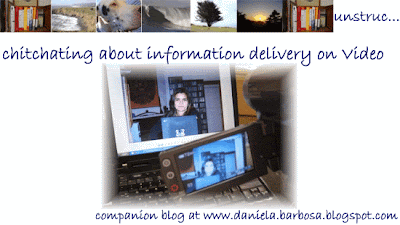Last week i was blablering to a whole bunch of people about APML, APML, attention, attention, attention~many probably thought the hot orlando sun and the poolside gin-n-tonics had something to do with it- but it isn't so and yesterday a whole group of new participants were announced as part of the APML group i am participating in adding some more industry leaders to the group that is tasked with converting the current specification into an agreed standard.
What does 'APML' stand for>
Attention Profiling Mark-up Language
Why will it be important>
On tuesday on the way to work i was listening to
Travus T. Hipp on
KPIG one of the best radio stations in the Bay area (online streaming available). Every chance i get to listen to Travus for his 8am rant i take it, and on tuesday the rant was on
Too Much News and how no one has the capacity to take it all in and how it is becoming "damn near impossible to keep up on the number of stories I need to have some background knowledge to produce opinions of better than average prediction". I was in the car- saying it is all about attention Travus all about attention-and he is just talking about consuming 'news' media, print, online, radio, tv etc.
Although as a consumer and a self professed news junkie i am looking forward to investigating APML for my own personal use, my primary interest with leveraging attention is in the enterprise- for example a user's profile as a worker using specific company provided systems (portal,CRMs,subscription services etc.) and internet online 'free' resources (with the ability to turn off attention tracking easily of course on non-enterprise tools)- this however brings a whole bunch concerns by knowledge workers that i am sure you can imagine and i will touch upon on future posts.
What will APML do>
From the
website:
APML will allow users to export and use their own personal Attention Profile in much the same way that
OPML allows them to export their reading lists from Feed Readers.The idea is to boil down all forms of Attention Data – including Browser History,
OPML, Attention.XML, Email etc – to a portable file format containing a description of ranked user interests.
The new participants announced this week include:
Sam
Sethi (
Vecosys)
Daniel
Winterstein (
ThinkTank Maths)
Steve Williams (Programmer,
Digg)
David Cancel (Co-Founder,
Compete.com)
Richard Giles/Graeme Sutherland (Co-Founders,
Scouta.com)
Elias
Bizannes (
PricewaterhouseCoopers)
They join the existing group:
Chris
Saad/Ashley
Angell (Co-Founders,
Faraday Media/
Touchstone)
Paul Jones (Senior Architect,
Faraday Media/
Touchstone)
Mitch
Ratcliffe (Co-Founder,
Buzzlogic)
Chris
Messina (
Citizen Agency)
Phil
Morle (VP Attention,
Yoick)
Ben
Metcalfe (Social Media Consultant)
and me.
The group has started its work with a
revised spec. More information can be found on the
APML website at
http://www.apml.org/And yes, we invite all the players in or around the Attention Economy to join us in refining, implementing and evangelizing
APML. To join the
Workgroup please
contact us with your qualifications. Members of the general public are invited to join the mailing list (via the
APML.org website) forums or blog to provide feedback.
 I haven't been out and about in the SF scene in the last three months which means i have given flickr sightings a break and corporate is probably convinced i am hard at work but tonight i finally was in town and went to the SF Beta event- good cause i missed talking to some of these folks and meeting a whole bunch of new ones as well which is always good and there certainly were a lot of new faces.
I haven't been out and about in the SF scene in the last three months which means i have given flickr sightings a break and corporate is probably convinced i am hard at work but tonight i finally was in town and went to the SF Beta event- good cause i missed talking to some of these folks and meeting a whole bunch of new ones as well which is always good and there certainly were a lot of new faces.




